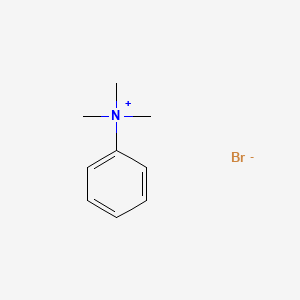



1. Hydroxide Of Phenyltrimethylammonium
2. Iodide Of Phenyltrimethylammonium
3. Phenyltrimethylammonium
4. Phenyltrimethylammonium Acetate
5. Phenyltrimethylammonium Benzenesulfonate
6. Phenyltrimethylammonium Bromide
7. Phenyltrimethylammonium Chloride
8. Phenyltrimethylammonium Tosylate
9. Phenyltrimethylammonium Tribromide
10. Phenyltrimethylammonium, Tri(methyl-3(2)h)-labeled Cpd
11. Trimethyl-d9-anilinium Hydroxide
12. Trimethylanilinium
13. Trimethylanilinium Iodide
14. Trimethylphenylammonium Hydroxide
15. Trimethylphenylammonium Iodide
16. X-tractelute
1. 16056-11-4
2. Phenyltrimethylammonium Bromide
3. N,n,n-trimethylbenzenaminium Bromide
4. Benzenaminium, N,n,n-trimethyl-, Bromide
5. N,n,n-trimethylanilinium Bromide
6. Trimethyl(phenyl)azanium;bromide
7. Phenyl Trimethyl Ammonium Bromide
8. Benzenaminium, N,n,n-trimethyl-, Bromide (1:1)
9. (n,n,n)-trimethylanilinium Bromide
10. N-phenyl-n,n,n-trimethylammonium Bromide
11. Ammonium, Phenyltrimethyl-, Bromide
12. Einecs 240-202-8
13. Ro 2-2979
14. Ammonium Trimethylphenyl-, Bromide
15. Schembl238552
16. Trimethyl(phenyl)ammonium Bromide
17. Dtxsid60884868
18. Phnyltrimethylammonium Bromide
19. Mfcd00011788
20. Akos015833051
21. Cs-w013166
22. As-66945
23. Db-050352
24. Ft-0656340
25. P0243
26. D77743
27. A810149
28. Q63393463
| Molecular Weight | 216.12 g/mol |
|---|---|
| Molecular Formula | C9H14BrN |
| Hydrogen Bond Donor Count | 0 |
| Hydrogen Bond Acceptor Count | 1 |
| Rotatable Bond Count | 1 |
| Exact Mass | 215.03096 g/mol |
| Monoisotopic Mass | 215.03096 g/mol |
| Topological Polar Surface Area | 0 Ų |
| Heavy Atom Count | 11 |
| Formal Charge | 0 |
| Complexity | 95.8 |
| Isotope Atom Count | 0 |
| Defined Atom Stereocenter Count | 0 |
| Undefined Atom Stereocenter Count | 0 |
| Defined Bond Stereocenter Count | 0 |
| Undefined Bond Stereocenter Count | 0 |
| Covalently Bonded Unit Count | 2 |
Indicators and Reagents
Substances used for the detection, identification, analysis, etc. of chemical, biological, or pathologic processes or conditions. Indicators are substances that change in physical appearance, e.g., color, at or approaching the endpoint of a chemical titration, e.g., on the passage between acidity and alkalinity. Reagents are substances used for the detection or determination of another substance by chemical or microscopical means, especially analysis. Types of reagents are precipitants, solvents, oxidizers, reducers, fluxes, and colorimetric reagents. (From Grant and Hackh's Chemical Dictionary, 5th ed, p301, p499) (See all compounds classified as Indicators and Reagents.)